A Railroad Runs Through It
The Relationship Between Millikin University and the Railroads
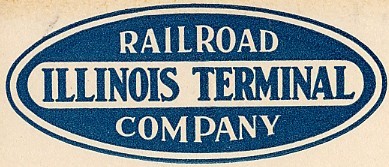

When Millikin University first opened its doors to students in 1903, the brand new campus had two different railway lines that helped to form its eastern and southern boundaries. At the east end of campus, cutting diagonally across the southeast corner were the tracks of the Wabash Railroad and in the center of West Main St., the southern boundary and "front" of the campus, were rails and electric cables for the Decatur Railway & Light streetcar which would soon link up with the "Interurban" or Illinois Traction System that would later be called the Illinois Terminal Company.
The close proximity of the railways to campus, and Decatur being such an important railway hub in general, meant that Millikin University and the railroads would have long and interesting relationships over the coming years. This exhibit tells story of those relationships, utilizing materials from the Millikin University Archives & Special Collections.
 |
This map shows the railways that ran through the Millikin Univeristy Campus (Green). The red shows the Wabash Railroad tracks and the blue shows the Decatur Railway & Light streetcar tracks which the "Interurban" used as well (blue arrows point to "diamond sidings" which were used as Illinois Traction System stops. [Colors were added to enhance the map for this exhibit - Map courtesy of Dale Jenkins] |
Campus Corner and Cornerstone
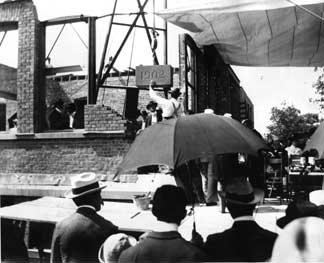 | 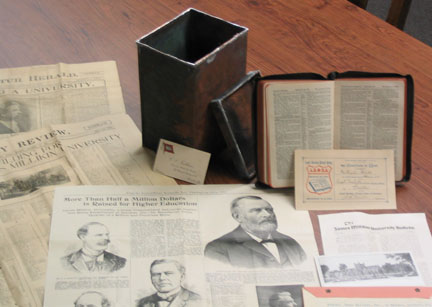 |
| The laying of the cornerstone in 1902 and items found within the copper box placed in the cornerstone when it was opened in 2003. |
When the cornerstone for the first building of the James Millikin University was laid in June of 1902, the Wabash railroad played an important part. Several items were placed inside a copper box that was itself then placed inside the cornerstone. The copper box had been donated by an original member of the University's Board of Managers, C.S. Needham of the Wabash Railroad.
Front of CS Needham's business card placed inside the cornerstone in 1902
 | Front of Card |
 | Back of Card |
This is the business card of Mr. C.S. Needham (above), which was placed inside the copper box he donated along with the other items, which is where it once again resides today.
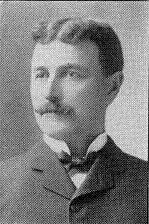
Just as they were involved in the cornerstone of the original campus building, it could also be said that the Wabash Railroad tracks make up the "cornerstone" of campus, as the tracks have cut across the southeastern corner of campus since Millikin University opened in 1903 and frieght trains still pass through on them several times a day and, much to the chagrin of student's who live in dorms & apartments near them, several times a night also!
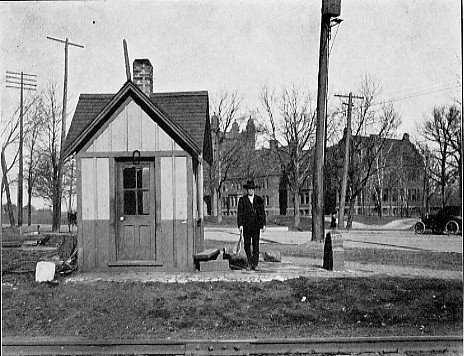 |
| Watchman Tommy" ~ From the 1906 Millidek |
Initially, at the southeast corner of campus, where West Main Street and Oakland Avenue meet, both roads were crossed by the Wabash tracks.

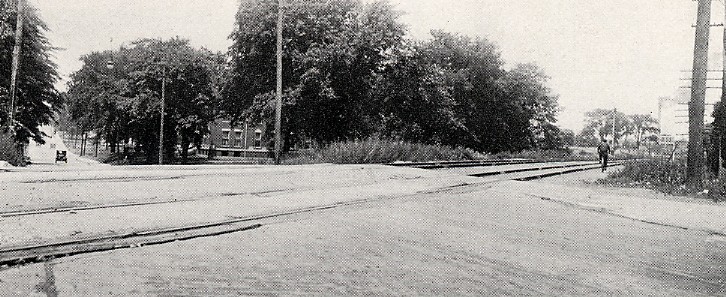
The blue box on the above map shows "the corner" and this photo shows the tracks where they crossed Oakland (looking north at Anna B. Millikin home behind trees at center). Both the map and image come from The Decatur Plan of 1920 which can be found in the Archives. |
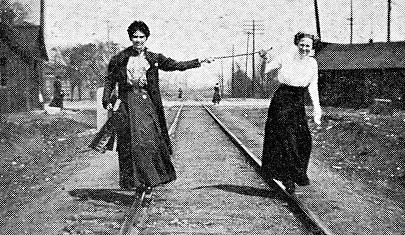
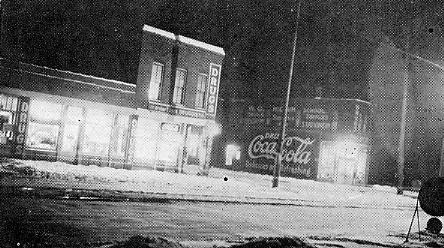
| This image, from the 1910 Millidek, looks north on the Wabash tracks with West Main St. in the background. Tommy & his cabin can be seen on the left. | This winter photo, from the 1923 Millidek, shows the Davis Drugstore at West Main Street and Oakland Avenue corner (southeastern part) with the streetcar tracks visible in the street. |
Up until 1910, the corner was manned by a flagman who went by the name of "Watchman Tommy." He was a campus fixture and inspired this 1906 ballad:

| from 1906 Millidek |

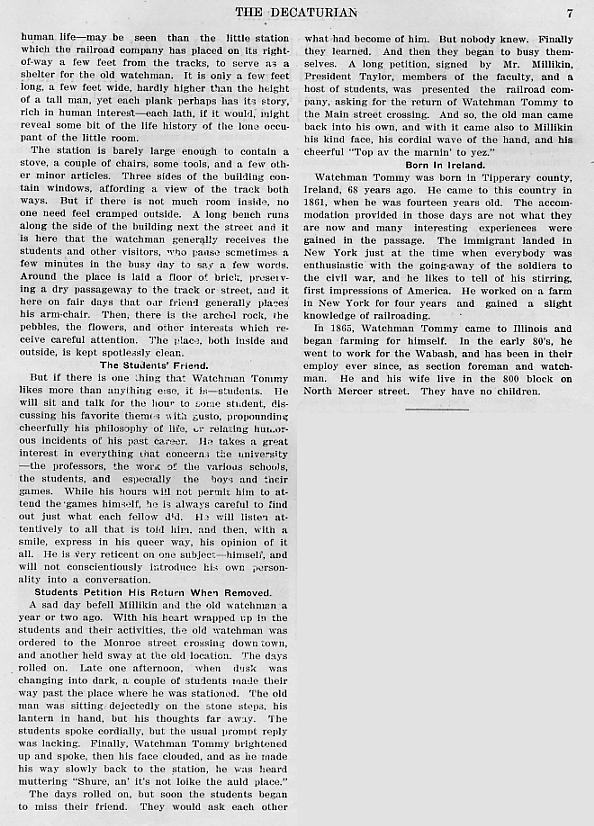
| The Decaturian November 1908 pages 6-7 | |
At some point during the 1909-1910 academic year though, Tommy's flags were replaced with electric signals, and a campus fixture was no more.
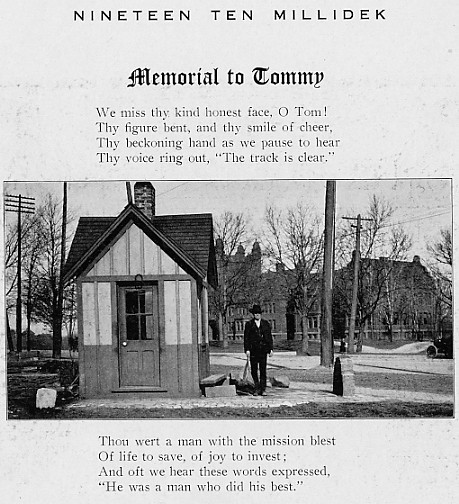

| Both from the 1910 Millidek | |
Despite the signals, having a high-traffic railway cross two high-traffic streets on a busy college campus was not a highly desirable situation, so in 1936, construction began on underpasses that would allow both West Main Street and Oakland Avenue to pass under the Wabash tracks. Although the yearlong construction project wasn't exactly met with jubilation, when the "subways" finally opened, jubilation was the order of the day!

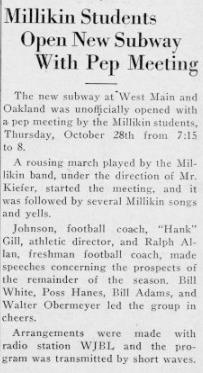

The Decaturian ~ December 11, 1936 p.2 , The Decaturian~November 5, 1937 p.1, The Decaturian ~ November 5, 1937 p.2

| Late 1930s aerial photo that shows the new "subway" underpasses in the circled area |
There was not an issue with the West Main Street streetcars and the underpass as that service had ceased (replaced by buses) in the early 1930s.
A Streetcar Named Inspire?
With a major railroad and a streetcar line both cutting through campus, it is no wonder that they provided students with "inspiration" for both leisure and academic pursuits, becoming "metallic muses.”
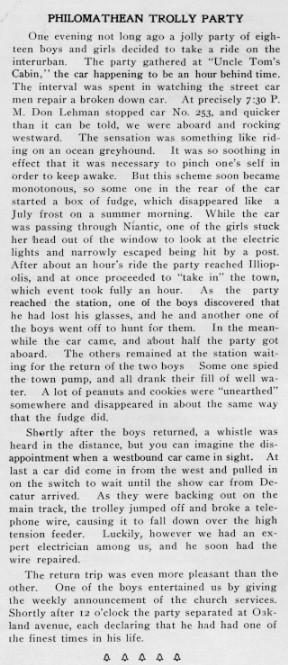
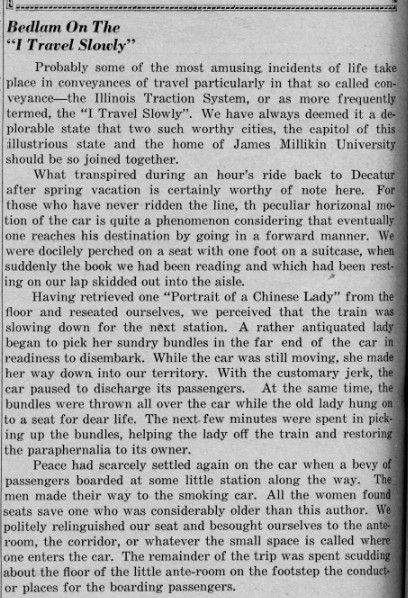
| The Decaturian ~ October 1904 p.4 | The Decaturian ~ April 16, 1937 p.2 |
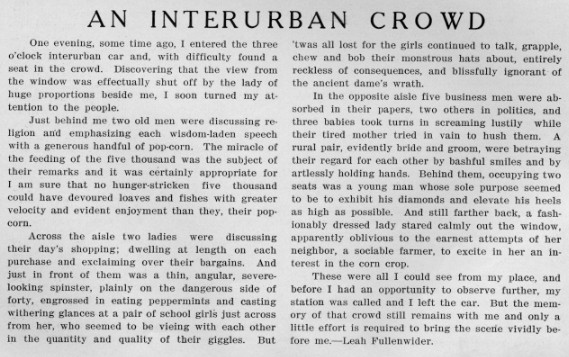
| The Decaturian ~ January 1910 p.7 |
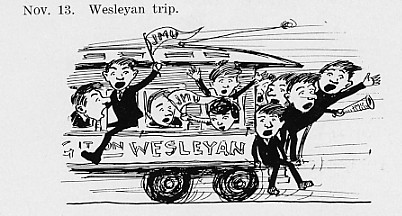
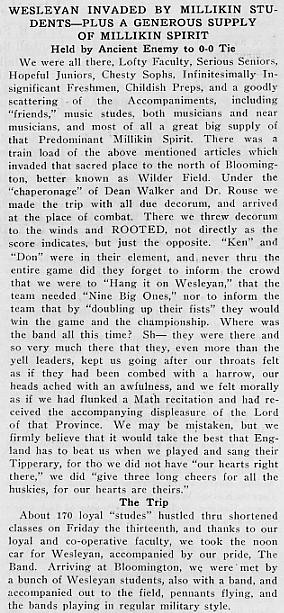
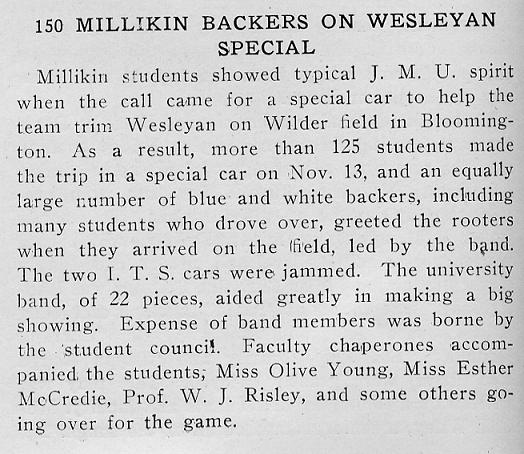
| "SPECIALS" ADDED TO ILLINOIS TRACTION and WABASH TRAINS FOR MILLIKIN AWAY GAMES | |
| 1915 Millidek image & related story from the December 1915 Decaturian pages 25-26 | December 1920 Decaturian page 8 and page 9 |

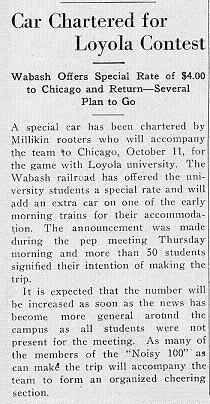
The Decaturian 9 Oct 1924 p.1
The "tracks" also offered photographic opportunities, albeit dangerous places to pose.
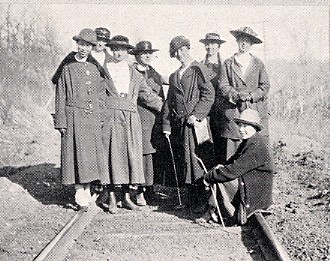

| From 1919 Millidek | From the 1920 Millidek |
Even when it came to academic pursuits, early Millikin students saw the railroads as topic for study, as several early students did their senior theses (when this was still a requirement to graduate) on topics ranging from the History of the Wabash to Freight Traffic on the ITS. Even Engineering students got into the act, creating working designs for various components involved in railroad & streetcar equipment.
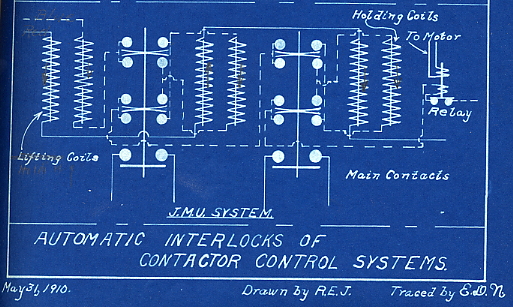
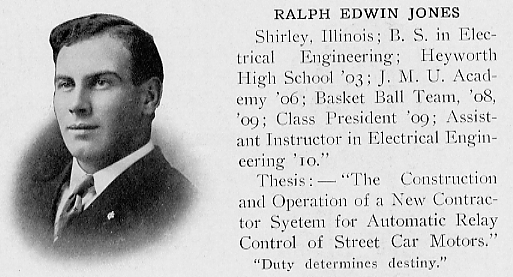
| (Top) Scan of blueprint from Ralph E. Jones' Thesis, the title of which is listed in his Senior Class entry from the 1910 Millidek (above) |
The 1930-31 Decaturian featured a weekly column entitled "Across The Wabash”

The Dec 15 Sept 1930 p.5
Even as late as 1950, the railroads were providing inspiration, as in the case below from the front page of an annual "April Fool's" edition of The Decaturian which were always filled with humorous phony news stories.

Purveyor of Presidents
Three sitting U.S. Presidents have visited Millikin since the University was founded and the first two of those both depended upon the railroad to get to and from Millikin. In June of 1903, President Theodore Roosevelt arrived as his special train was backed down the Wabash tracks that passed through campus. School children and other Decaturites crowded the new campus behind ropes that left a path for Roosevelt to walk to a stage and officially dedicate the new university which would open that fall.
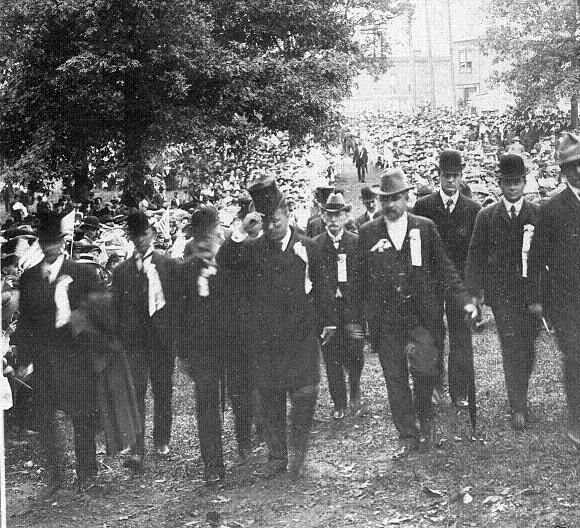
President Roosevelt (center tipping his hat) walks from his special train to stage through the roped off crowds.

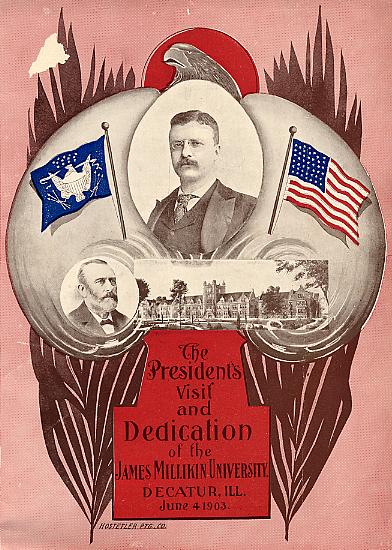
| The President giving his Dedication speech at Millikin | Cover of the Dedication program - June 4, 1903 |
When the dedication ceremony ended, the President's train took security and the band to the Wabash station while the President was carried by horse drawn carriage through crowds that lined Decatur streets until he arrived at the Wabash station to re-board his special train. He gave another speech at the station.

President Roosevelt speaks to crowds gathered at the Decatur Wabash Station to see him off after he had dedicated Millikin University.
Just eight years later, on Saturday, February 11, 1911, President William H. Taft visited Decatur and gave a speech inside Millikin's auditorium (today's Albert Taylor Theatre). Taft had arrived on campus by motorcar after giving a speech in downtown Decatur, but he would leave campus and head to Springfield via a special ITS train that was waiting for him in front of Millikin on West Main Street.
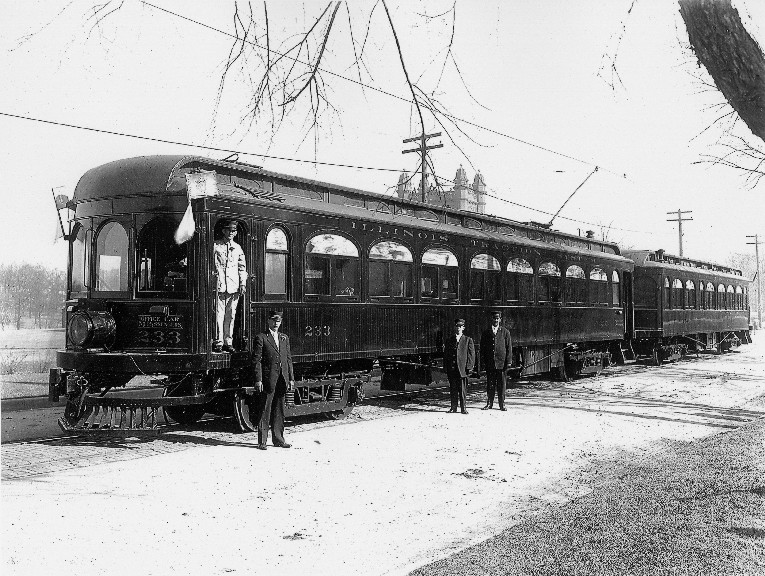
Taft's special ITS train awaits him on West Main Street in front of Millikin (the towers can be seen in the background above the center of the first car) photo courtesy of Dale Jenkins
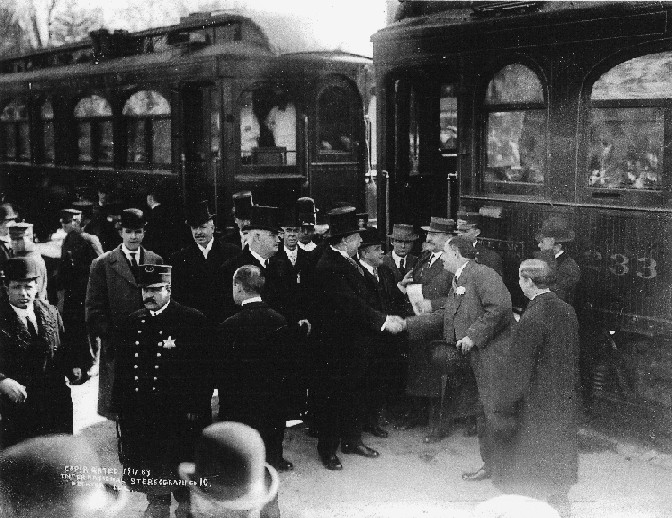
President Taft (center) shakes hands prior to boarding his train to Springfield on West Main Street. photo courtesy of Dale Jenkins

The cover of the February 1911 Decaturian with photo posed shortly before Taft boarded the special ITS train to Springfield. The "Rep. McKinley" mentioned in the caption (he is the shortest person in the picture, second person to the right of the President) is Representative William B. McKinley who also happened to own the Illinois Traction System.
Ronald Reagan was the third, and most recent, sitting President to visit campus in August of 1984, although his visit did not involve rail travel.
The "Interurban”
Today's Millikin students are still readily aware of the old Wabash tracks as several times a day and night freight trains pass through campus on them, as their horns blow and the ground on campus vibrates as the heavy cars pass. They are also aware of the heavy automobile traffic on West Main Street, as many need to cross it several times a day, and they might even see a Trolley (now a bus designed to look like a streetcar) pass through campus, but few if any have any idea that the center of that street once held iron rails and that electric streetcars and Interurban trains once passed regularly along the front of campus.


Views of West Main Street in front of campus buildings. The top image is looking Northwest from the southeast corner of campus and the lower image is looking northest from the southwest corner. The "A" shows where overhead cables ran overhead down the center of West Main for the electric "Interurban" trains & streetcars while the "B" shows the rails in the center of the street.
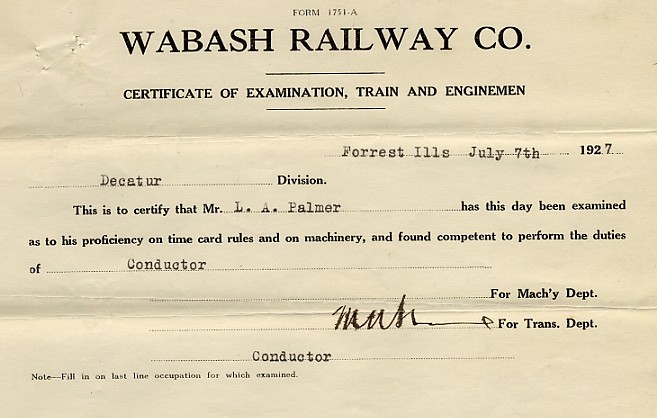
The rails running in front of Liberal Arts Hall (today's Shilling Hall) on West Main St. It is interesting to note the brick in West Main St as the portion of West Main that runs in front of campus will be returned to brick pavement in the summer of 2008. (From the 1917 Millidek)
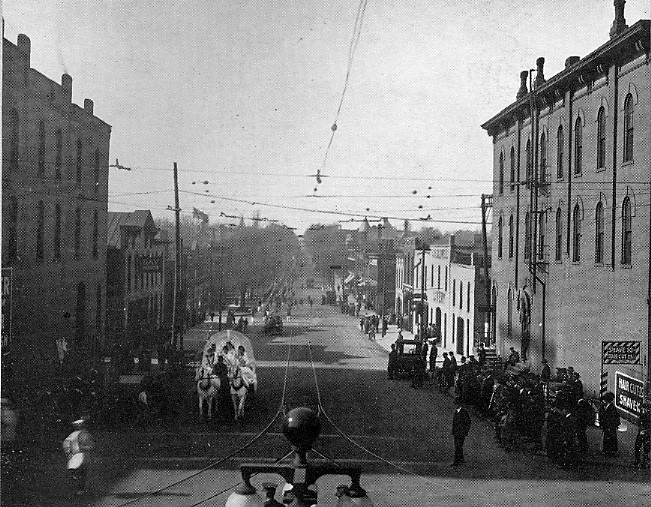
This picture of the homecoming parade in 1915 shows the rails going down West Main Street as they enter downtown Decatur. (From the 1916 Millidek)
The Interurban or Illinois Traction System (later Illinois Terminal) which regularly passed in front of campus going between Springfield and the Transfer House in Decatur began operating on Sept 17, 1904, just a year and two days after Millikin University had first opened its doors. William B. McKinley and his associates had also bought and consolidated the local streetcar company into Decatur Railway & Light Company in December 1903. Both DR&L streetcars and the Interurban electric trains used the West Main Street rail line and both continually sought Millikin student commuters.

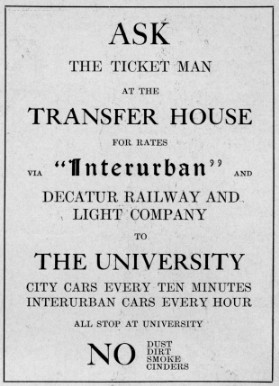
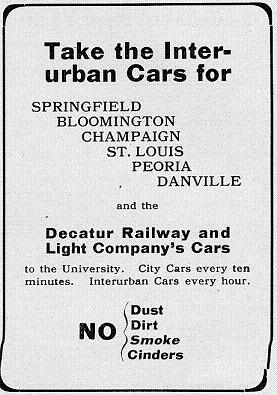
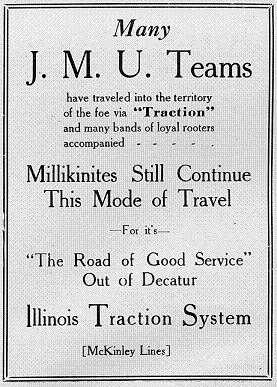
| Ad from The Decaturian Nov 1904 p.23 | Ad from The Decaturian May 1907 p.19 |
| The Decaturian September 1907 p.17 | The Decaturian December 1920 p.29 |

Ad from The Decaturian October 1909 p.29

Ad from The Decaturian 28 Sept 1911 p.5
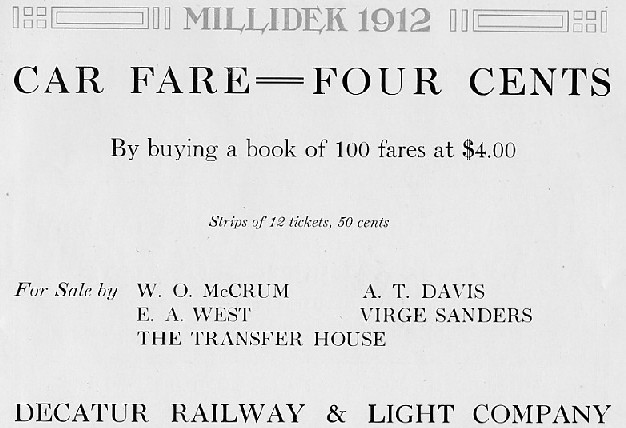
Ad from the 1912 Millidek

The Decaturian 29 Sept 1921 p.3
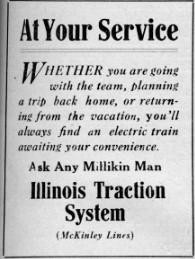
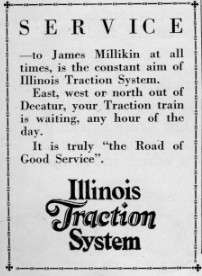
The Dec 29 Sept 1921 p5 & The Dec 13 Sept 1926 p6
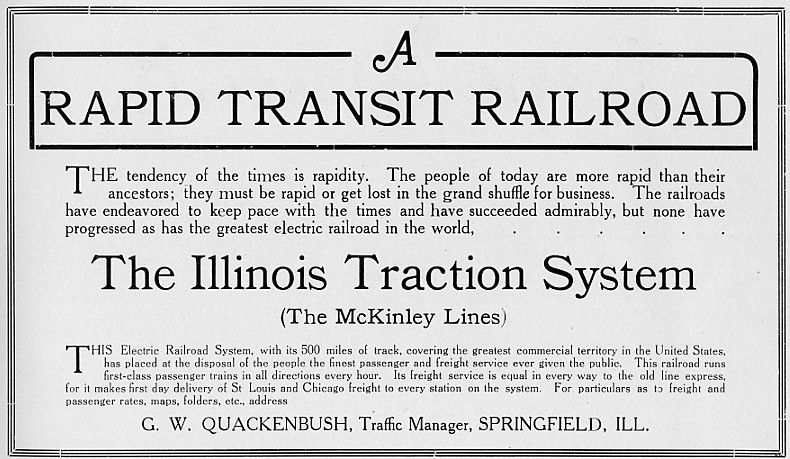
Ad from the 1910 Millidek
For a few of those early years, the ITS shops were actually located right across Fairview Avenue to the west of campus in the old Leader Manufacturing Co. property.
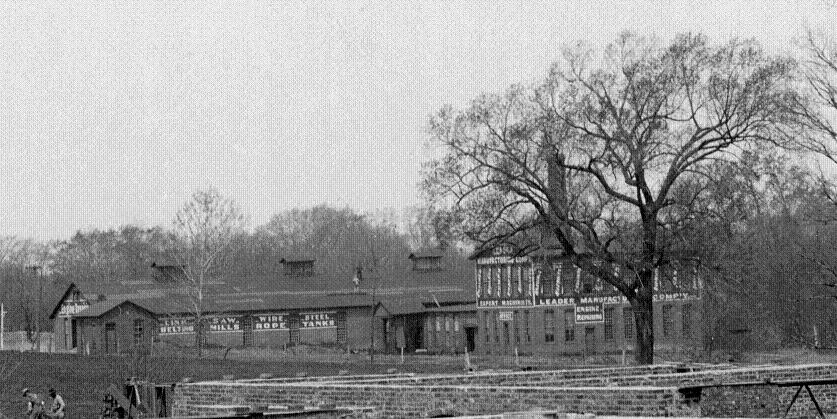
This image from 1902 shows the old Leader Mfg. Company. The bricks in the foreground are actually the construction of the original Millikin University buildings (today's Shilling Hall).
The shops of the ITS were only there from 1904 to early 1907, though they had hoped to make the location the site of their permanent shops. It seems that those owning the land adjacent to the ITS shops wanted to take advantage of the property's close proximity to Millikin and develop a residential subdivision there and so the ITS moved across town and the street Park Place and the Park View subdivision grew up in its place.
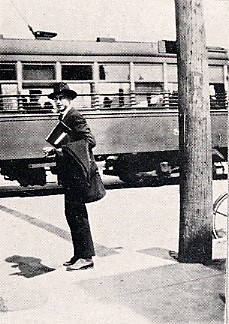
A student or faculty member with streetcar backdrop from the 1919 Millidek
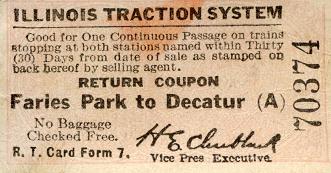
An ITS ticket stub
Perhaps the ITS & DR&L had been too encouraging to Millikin students. As early as 1905, the city of Decatur had passed an edict against loitering in the Transfer House and appointed a special officer to enforce it. It seems that many Millikin men had staked claim to the Transfer House as their nightly hangout downtown and apparently were thought to be quite the nuisance.

The Decaturian February 1905 p.8
By the early 1930s however, the Interurban trains passed on the belt line to the north of campus and streetcars no longer ran on West Main Street, replaced by buses.
Millikin on the Menu and the Movie Screen
The impact the railroads had on the Millikin campus and community though was not strictly a one-way road. The University had some influence of its own towards the railroads.
In the late 1940s, Illinois Terminal streamliners were offering a menu to their passengers that featured Millikin University on its cover.

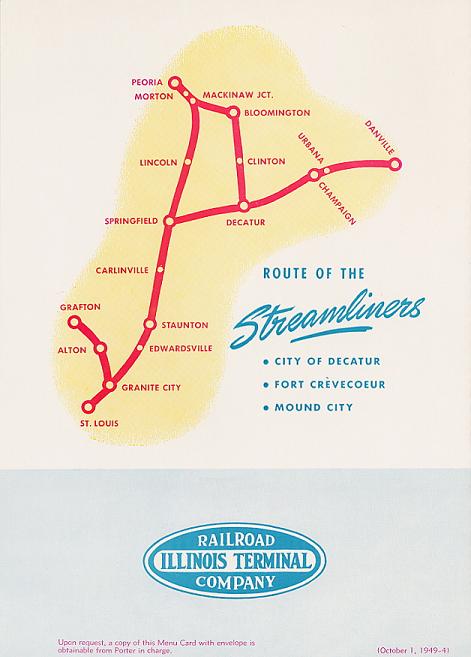
| Front and back cover of the Illinois Terminal Railroad Menu | |


| The inside of the menu, featuring a brief history of the University opposite Spaghetti for a quarter | |
When the Wabash Railroad set out to create a promotional film for its Bluebird passenger train, Millikin students quite literally got "into the act.”

The Decaturian 3 Oct 1952
The film was screened in cities and towns along the Wabash line and as many of these were celebrating centennials in the early 1950s, it was often incorporated into centennial celebrations. When the Wabash Railroad celebrated its centennial in Decatur in 1954, not only was Once Upon The Wabash shown but an entire musical pageant was put on again featuring Millikin students.
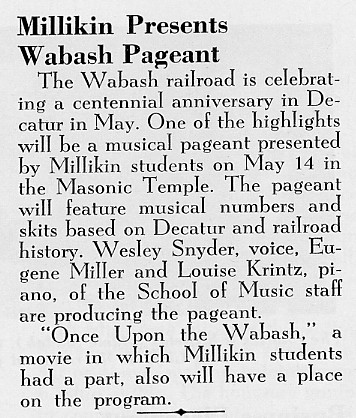
from the Alumni Bulletin May 1954 p2

The Dec 14 May 1954 p.1
A DVD version of Once Upon The Wabash is in the Archives & Special Collections room.
A Conductor's Collection
One of the more interesting small collections in the Millikin Univeristy Archives are a set of papers and ephemera related to L.A. Palmer, a conductor on the Wabash.

This 1927 certificate shows L.A. Palmer had passed the Conductor's exam, prior to that he had been a brakeman.

While still a brakeman back in 1924, Palmer was commended for flagging another train about cattle on a bridge.
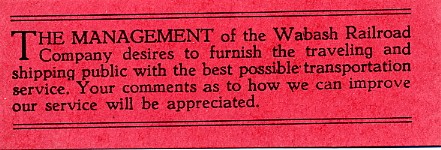
The collection contains loads of these small little red comment cards, which conductors likely handed out to passengers.
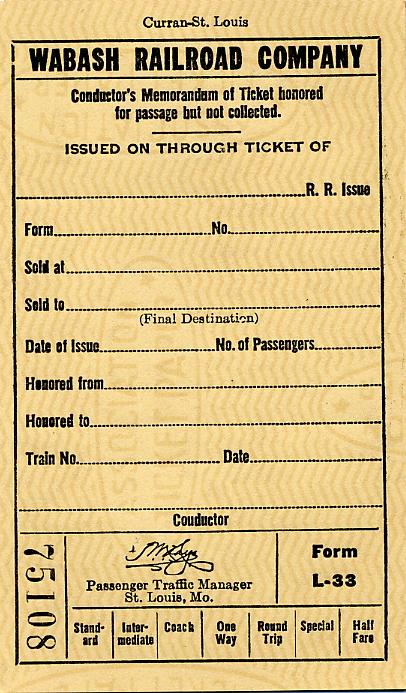
The collection also includes a pad of these memo tickets

A small pad of these Train registering tickets is also part of the Palmer collection
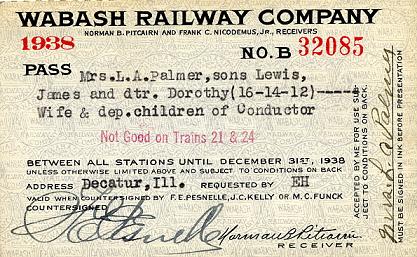
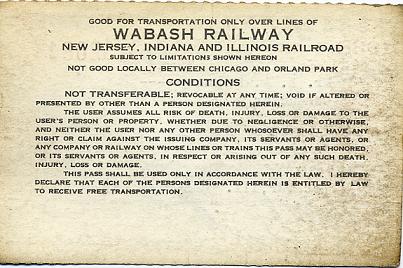
| Several of years worth of Palmer's train passes and those for his family are included in the collection, including this one from 1938 for his family (back of pass is shown on right) | |
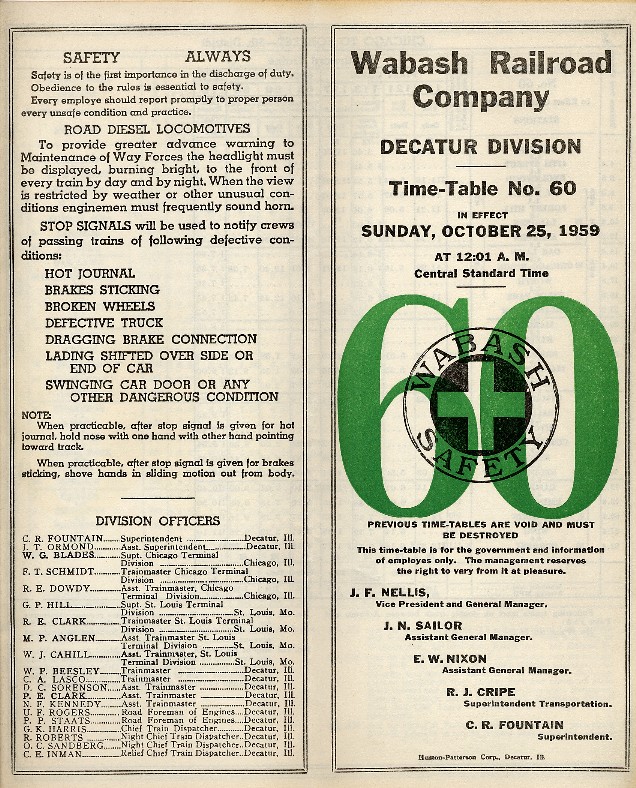
This Wabash timetable pamphlet is also part of the collection
During World War II
Just as the Millikin campus, and Millikin students, faculty, and alumni played significant parts in the U.S. war efforts, the railroads likewise did all they could.

Army Air Corps cadets arrive at Millikin via the Wabash from St. Louis. They disembarked at William Street near the Millikin campus in February 1943.
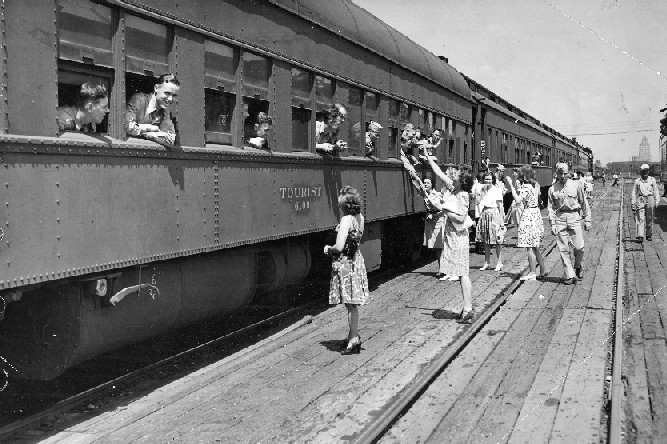
The last group of Army Air Corps cadets to train at Millikin University are sent off by well-wishers at the Decatur Wabash station in June 1944.
To learn more about the Army Air Corps cadets at Millikin, or more about Millikin during the Second World War, check out Millikin During the Second World War.
Illinois Central
Though it didn't cut through campus like the Wabash and Interurban did, the Illinois Central nonetheless served Decatur, and thus, Millikin students for many years, often discounting tickets to students, as did the other railroads.
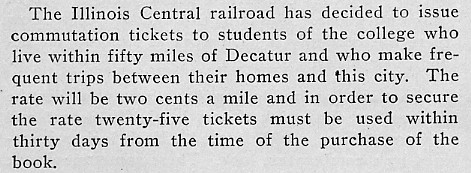
The Decaturian January 1904 p.12
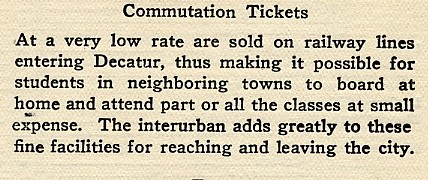
JMU Bulletin Catalog February 1905 p.35
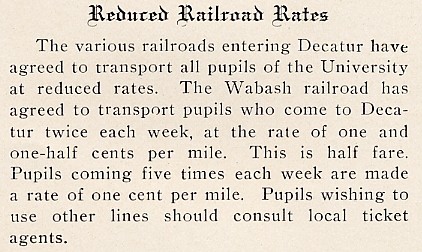
JMU Bulletin Catalog August 1905 p.15
In 1936-37, the Illinois Central ran a series of adds in college newspapers, including the Decaturian, and ended that academic year with an essay contest and cash prizes.


| Ad from The Decaturian 23 Oct 1936 p.3 | Ad from The Decaturian 11 Dec 1936 p.3 |
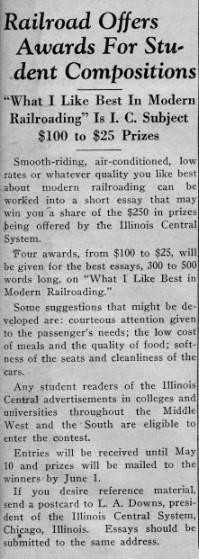
The Dec 30 Apr 1937 p.1
Tracks & Tragedy
Having tracks in such close proximity to campus has its dangers. The main reason the underpasses were built in the late 1930s was to avoid accidents as the trains crossed the busy roads. Despite all the precautions though, at least two students have died when struck by trains.

The Decaturian 12 Feb 1931 p.1
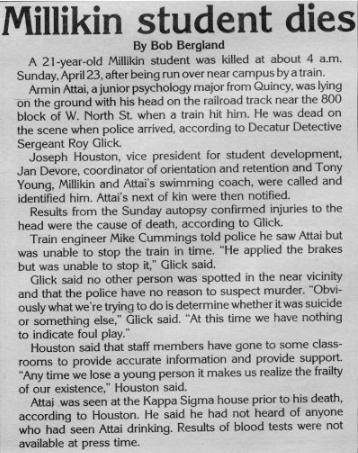
The Decaturian 26 April 1989 p.1
Final Note
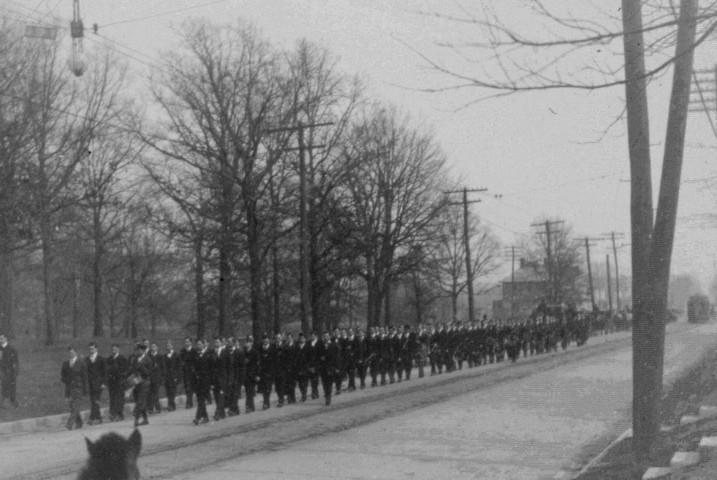
Millikin students walk along the rails on West Main Street as they escort the body of James Millikin to the university. Mr. Millikin's body (in a carriage behind the formation of students) had arrived at the Wabash station from Orlando, Florida where he had died on March 2, 1909. A streetcar can be seen coming up the tracks at the far right of the image.
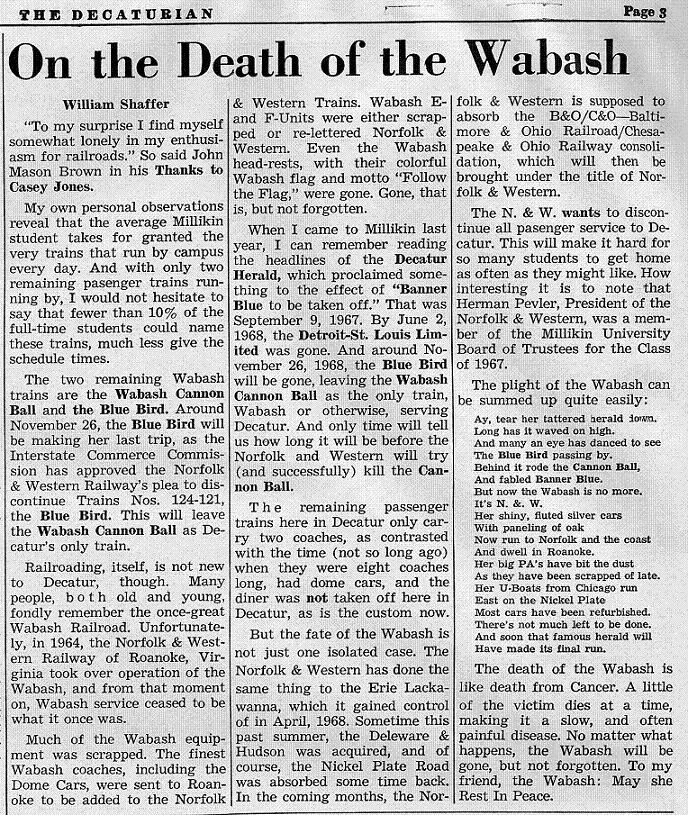
Nearly sixty years after Mr. Millikin was brought home to his final resting place via the Wabash, a Millikin student eulogized the Wabash in the student newspaper, The Decaturian, on November 1, 1968, page 3.
Though passenger rail service is no longer offered in Decatur and today's Millikin students experience only freight trains and bus trolleys, the railroads that once served Millikin students remain forever linked to the university.
This exhibit would not have been possible without the information, images, and encouragement provided by Dale Jenkins, President of the Illinois Traction Society. The Millikin University Archives thanks him for all his kind assistance.
Additional research materials included:
Decatur's Growth As a Railroad Centre: 1854-1954 and Before & After by Jack Aldrich (1994: Jack Aldrich)
Illinois Terminal: The Electric Years by Paul H. Stringham (1989: Interurban Press)
Follow The Flag: A History of the Wabash Railroad Company by H. Roger Grant (2004: Northern Illinois University Press)
and
The Flyer: The Magazine of Illinois Terminal Railroad History Vol. 19 No.1 Spring 2005 (issue all about Decatur and the ITS)
This page created September 25, 2007 by Todd Rudat
Last Modified: April 16, 2008
Copyright: Millikin University Board of Trustees